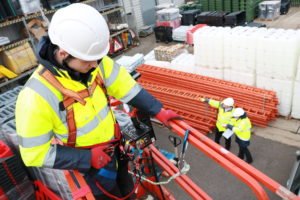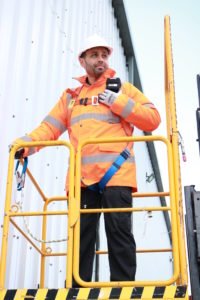Working at height
Prevention is better than cure: Securing tools when working at height
Being struck by a falling, flying or moving object is the third highest cause of injury in the construction industry, killing about four people each year and injuring thousands more. Tethering tools can dramatically reduce the risk of them being dropped and causing serious harm, says OnSite Support’s Damian Lynes.
 While the Health and Safety Executive does not identify the number of fatal and non-fatal injuries caused by objects falling from height, there is a good chance that this is the cause of many incidents. Even a tape measure can kill (and tragically has done so in the US) – a 500g object dropped from 15m has the same impact energy as a 75kg washing machine.
While the Health and Safety Executive does not identify the number of fatal and non-fatal injuries caused by objects falling from height, there is a good chance that this is the cause of many incidents. Even a tape measure can kill (and tragically has done so in the US) – a 500g object dropped from 15m has the same impact energy as a 75kg washing machine.
Despite this, there is no specific UK guidance on how to prevent materials, tools and other objects falling from height. So, while the Working at Height Regulations 2005 state employers must take ‘suitable and sufficient steps’ to prevent the fall of materials and objects and stop anyone being hit, it is left up to companies as to how they decide to tackle the issue.
Of course, a risk assessment will form the basis of any strategy. This should consider the safety of those carrying out the work, plus anyone working or moving in, around and beneath the working area, as well as the general public, if appropriate. This assessment should also consider the time lost from dropped objects and the cost of replacing damaged tools and materials.
Exclusion zones

Common approaches include fitting toe boards and netting to prevent anything reaching the ground, along with exclusion zones around the working area. However, it is important to remember that objects bounce and can ricochet as they fall, which can render these measures ineffective: experiments have shown that a 3.6kg spanner falling from 67m and hitting a bar 6m off the ground travelled up to 128m horizontally.
With this in mind, prevention is better than cure, so secure storage of materials and tools is critical when working at height. When it comes to tools, belts, harnesses and tethering offer an excellent first line of defence.
As with most PPE, choosing the right tethering system requires careful consideration, as many tasks involve using many different tools and exposure to multiple risks. And, while safety is the priority, productivity is still important.
Comfort is another key consideration – a well-fitting tool belt or harness, that is also useable, will ensure users wear and use it correctly. Actively involving workers in selecting tethering systems should result in people being more likely to wear them.
A wide range of tool tethering systems are available, ranging from simple lightweight lanyards to those designed for attaching heavy power tools, water bottles, mobile phones and even iPads. There are also retractable systems to prevent lanyards getting entangled and systems that allow tools to be changed quickly and easily, wrist straps and loops that allow tools to be swapped between hands safely.
Training
With managing health and safety compliance in the supply chain is a big challenge, educating subcontractors is important and making it as easy and inexpensive as possible for them to comply is important. In this instance, using tethered systems does not necessarily mean replacing tools either; tools can be retrofitted with loops and rings so they can be attached securely to belts and lanyards.
Training is vital, to ensure everyone understands the risks and how they can be mitigated. It is also worth speaking to PPE suppliers, who will visit site to audit the work and provide independent and expert advice on the most appropriate systems for activities and working conditions. Some will also give toolbox talks and ‘hands-on’ training that mirror the safety messages organisations want to promote.
Prevention is better than cure: Securing tools when working at height
Being struck by a falling, flying or moving object is the third highest cause of injury in the construction industry, killing about four people each year and injuring thousands more.
Safety & Health Practitioner
SHP - Health and Safety News, Legislation, PPE, CPD and Resources Related Topics
Are you meeting your responsibilities as a buyer of PPE and safety equipment?
Gogglebox star George Gilbey died after fall through skylight
Inclusivity in PPE: The manufacturer’s perspective

 While the
While the 
Even when working on towers and masts from the early 80’s, I always had my tools on lanyards. Maybe then it was more for the fact you didn’t want to be climbing down and back up 42m if you dropped your spanner! It makes sense and doesn’t make the job anymore difficult.